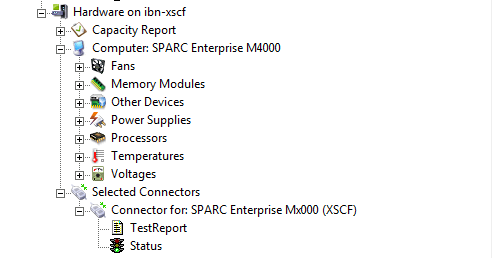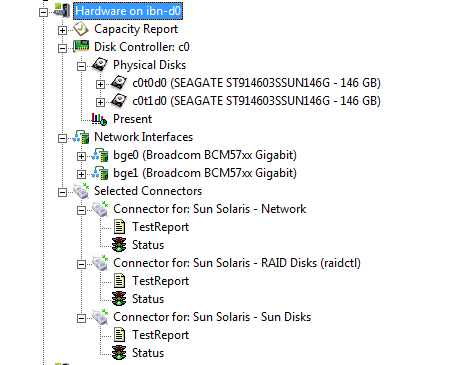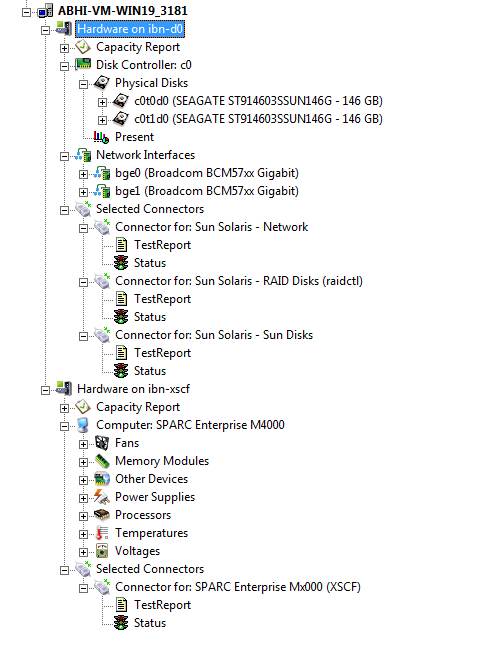Contents
- The Hardware Instrumentation section covers the basic Sun Fire M4000, M5000, M8000 and M9000 Servers hardware components and the supported communication protocols.
- The Setting up... section provides detailed instructions for installing and configuring Hardware Sentry KM for PATROL to properly monitor Sun Fire M4000, M5000, M8000 and M9000 Servers.
- The Discovered Components and Monitored Parameters section lists the components automatically discovered and monitored by Hardware Sentry KM for PATROL as well as the connectors required to ensure a proper monitoring.
- The Monitoring the Entire System section describes the procedure to setup the monitoring of the entire system in case of a SUN Fire in reference to domain.
- The Troubleshooting section gathers the most frequently asked questions related to issues that stem from installation or configuration issues.
About Sun Fire Mx000 servers
The Sun Fire Mx000 servers (like Sun Fire M4000, M5000, M8000 or M9000) are the successors of the Sun Fire F12K, F15K, E20K and E25K systems. The Mx000 servers include many SPARC IV 64 processors, memory modules and I/O boards that can be partitioned to execute several instances of the Solaris operating systems (called domains).
Hardware instrumentation
The eXtended System Control Facility (XSCF)
Each Sun Fire Mx000 server comes with one or two “eXtended System Control Facility” boards (XSCF) which are the main interface for the administrators in order to configure the domains and allocated resources in the system.
The default way to work with the XSCF is to log on to the XSCF using the SSH protocol and execute commands to diagnose or configure the whole system.
Unlike the System Controller (SC) in the Sun Fire F12K, F15K, E20K and E25K, the XSCF is not a full blown computer running the Solaris operating system. It is more of a management card like the ALOM card. Because of that, the PATROL Agent and Hardware Sentry KM cannot be installed on the XSCF board and the monitoring must be performed remotely using the SSH protocol.
While the XSCF supports SNMP, the amount of information available through this protocol is rather weak and lacks some critical pieces that are available using the command interface of the XSCF. Therefore, Hardware Sentry will connect to the XSCF through SSH and execute commands to discover and monitor the status of the hardware components of a Sun Fire Mx000 server.
The commands used by Hardware Sentry to discover the components of a Sun Fire Mx000 system require the platadm or platoper privileges.
The XSCF has been originally designed by Fujitsu and is being used in other Fujitsu PRIMEPOWER systems.
Sun Management Center (SMC)
Hardware Sentry does not need and does not use the SMC agent to discover and monitor the hardware components of Sun Fire Mx000 systems.
Solaris system utilities on the domains
When executed in a specific domain, the Solaris system utilities usually used by Hardware Sentry KM to monitor sun4u systems could discover and monitor the hardware components allocated to the domain. However, because of the dynamic nature of the Sun Fire Mx000, it is not recommended to rely on these utilities to report the status of the hardware components in a consistent way.
Setting up Hardware Sentry on Sun Fire Mx000
The eXtended System Control Facility should be connected to the network and can be accessed through SSH
Installation procedure
- Install the PATROL Agent on a system that can access the XSCF over the network (versions 3.5.00 and upward are supported, version 3.9.00 minimum is recommended) if it has not been already done. It is not recommended to setup Hardware Sentry KM and the PATROL Agent on one of the domains of the Sun Fire Mx000 machine because the automatic monitoring of the local host may lead to false alerts due to dynamic resource reallocation (notably processors).
- Install Hardware Sentry KM for PATROL on top of the PATROL Agent (this can be done at the same time as the PATROL Agent). Please follow the instructions of the Installation Guide of Hardware Sentry.
Configuration
Once installed, Hardware Sentry will do its best to automatically discover and monitor the hardware components of the system it is running on. These components will be displayed under the main “Hardware” icon in the PATROL Console. Depending on the type of the platform of this system, the product may not be able to properly monitor it but it is not the purpose of this installation. Hardware Sentry needs to be configured to monitor the Sun Fire Mx000 server in addition to the local system it is installed on. To do so:
- Right-click on the main “Hardware” icon in the PATROL Console > KM Commands > Add a Remote System to Monitor…
- Accept the EULA
- Specify the name of the XSCF (this will appear in the console) and its IP address (if that does not correspond to the given name)
- Select “Management Card” as the system type and click Next
- Select the option “Manually choose which connectors to use” and click Next
- Select the “Sun Fire Mx000 (XSCF)” connector (and only this one) and click Next
- Choose “SSH” as the protocol to connect to the XSCF
- Enter a user account (and password) valid on the XSCF and which is member of the platadm or platoper group (on the XSCF)
- Click Next and then Finish.
Discovered components and monitored parameters
The following components and parameters are discovered and monitored:
- Server model
- Processors and status of each processor
- Memory modules and status of each memory module
- Fans and status of each fan
- Temperature sensors and actual temperature
- Voltage sensors, actual voltage and status
- Power supplies, status
- Domains and status of each domain
- I/O boards and XSCF status

Monitoring the Entire System
As an additional step, if you want to setup the monitoring of the entire system for SUN Fire, we also recommend to setup the monitoring of individual domains. In order to do so:
- Right-click on the main “Hardware” icon in the PATROL Console > KM Commands > Add a Remote System to Monitor…
- Accept the EULA
- Specify the FQDN name of the domain (this will appear in the console) and its IP address (if that does not correspond to the given name)
- Select “Sun Solaris” as the system type and click Next
- Select the option “Manually choose which connectors to use” and click Next
- Select the “Sun Solaris - Network” connector , “Sun Solaris - RAID Disks (raidctl)” connector and “Sun Solaris - Sun Disks” connector then click Next
- Choose “SSH” as the protocol to connect to the domain
- Enter a user account (and password) valid on the domain and which has proper privileges.
- Click Next and then Finish.

Normally, after this you have the entire system set up like the screenshot below:

Troubleshooting
The Sun Fire connector triggers an alarm
If the “Sun Fire Mx000 (XSCF)” connector icon triggers an alarm, it could mean that:
- The Java environment has not been properly configured in Hardware Sentry
- Hardware Sentry is using telnet to connect to the XSCF while only SSH is enabled
- The user credentials are not valid on the XSCF or do not have enough privileges to execute the required commands. You can check that configured user account has enough privileges by logging in to the System Controller and execute the “showhardconf” command.
Related Topics
- Monitoring Sun Fire F12K, F15K, E20K and E25K Servers with Hardware Sentry
- Monitoring Sun SPARC T1 and T2 systems (sun4v) with Hardware Sentry
- Monitoring Sun Solaris Systems (sun4u) with Hardware Sentry
- Monitoring Sun X86 and X64 Systems with Hardware Sentry
- Monitoring Sun StorageTek Disk Arrays with Hardware Sentry
